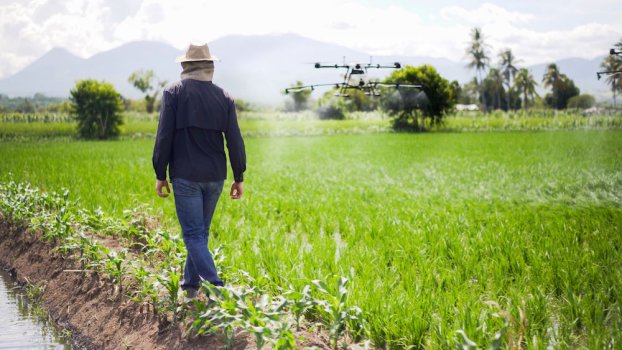K
Kathleen Martin
Guest
The amount of land and labor used on American farms has declined since the 1940s. Yet during the same period, agricultural output has nearly tripled, federal statistics show, because of one key factor: technology.
A main technological driver now boosting production in American agriculture is drones, which have enabled farms to increase crop yields while lowering pesticide use. The future of the agricultural industry, which recently celebrated National Farmers Day, lies in automating operations and adopting precision farming techniques, experts say.
Studies show that drones used in farming operations reduce costs. The average U.S. farmer using agricultural drones sees a return on investment of $12 per acre for corn, and $2 to $3 per acre for soybeans and wheat, according to research by the American Farm Bureau Federation.
“More farms are using drone technology and they are using better drone technology today than five years ago,” said Mohamed Mostafa, lead technical authority for mobile mapping for Applanix Corp., or Markham, Canada, which produces positioning and orientation systems for drones. “We have drones that fly longer times and have better cameras so you can see finer resolution on the ground.” Applanix is owned by software, hardware and services technology company Trimble.
Even small family-owned farms, which account for 90% of all U.S. farms, are integrating drones into their operations by contracting with service providers to deploy UAS for aerial mapping and crop spraying of fertilizer and pesticides.
With the average age of farmers in the United States rising to 57.5 years, drones are also helping to alleviate labor shortages and improving efficiency, said Louis Wasson, a senior extension associate at Mississippi State University and a drone instructor for USDA’s Wildlife Services.
“Drones save farmers a lot of time in not having to go out and spend time walking and looking at things,” Wasson said. “They can send the drone up and look at that precision spot. And you’re not spraying as much.”
Beyond Tractors and Crop Dusters
While farms have traditionally used tractors or crop dusters to spray crops with fertilizer and pesticides, that function is gradually being taken over by drones. Unmanned systems allow farmers to accurately pinpoint specific areas that need nutrients or protection from insects.
Tractors or crop dusters use a blanket approach to apply pesticides on entire fields, when only a portion of the crop may need applications of chemicals to control weeds, said Arthur Erickson, CEO and cofounder of Hylio, a Richmond, Texas-based company that produces agricultural drones.
“What tractors can’t do is spot treatment,” Erickson said. “Once the crop has started growing and it’s showing signs of fungus outbreak or some sort of weed outbreak in different sections of the field, you can’t go out there and isolate those spots and just spray that. You have to come in and spray everything—a shot-gun approach.”
This indiscriminate approach not only causes farmers to overspray pesticides, but it also carries health and environmental risks because of pesticide drift, the movement of pesticide dust or droplets through the air.
Continue reading: https://insideunmannedsystems.com/u-s-farms-embrace-drone-technology-benefits/
A main technological driver now boosting production in American agriculture is drones, which have enabled farms to increase crop yields while lowering pesticide use. The future of the agricultural industry, which recently celebrated National Farmers Day, lies in automating operations and adopting precision farming techniques, experts say.
Studies show that drones used in farming operations reduce costs. The average U.S. farmer using agricultural drones sees a return on investment of $12 per acre for corn, and $2 to $3 per acre for soybeans and wheat, according to research by the American Farm Bureau Federation.
“More farms are using drone technology and they are using better drone technology today than five years ago,” said Mohamed Mostafa, lead technical authority for mobile mapping for Applanix Corp., or Markham, Canada, which produces positioning and orientation systems for drones. “We have drones that fly longer times and have better cameras so you can see finer resolution on the ground.” Applanix is owned by software, hardware and services technology company Trimble.
Even small family-owned farms, which account for 90% of all U.S. farms, are integrating drones into their operations by contracting with service providers to deploy UAS for aerial mapping and crop spraying of fertilizer and pesticides.
With the average age of farmers in the United States rising to 57.5 years, drones are also helping to alleviate labor shortages and improving efficiency, said Louis Wasson, a senior extension associate at Mississippi State University and a drone instructor for USDA’s Wildlife Services.
“Drones save farmers a lot of time in not having to go out and spend time walking and looking at things,” Wasson said. “They can send the drone up and look at that precision spot. And you’re not spraying as much.”
Beyond Tractors and Crop Dusters
While farms have traditionally used tractors or crop dusters to spray crops with fertilizer and pesticides, that function is gradually being taken over by drones. Unmanned systems allow farmers to accurately pinpoint specific areas that need nutrients or protection from insects.
Tractors or crop dusters use a blanket approach to apply pesticides on entire fields, when only a portion of the crop may need applications of chemicals to control weeds, said Arthur Erickson, CEO and cofounder of Hylio, a Richmond, Texas-based company that produces agricultural drones.
“What tractors can’t do is spot treatment,” Erickson said. “Once the crop has started growing and it’s showing signs of fungus outbreak or some sort of weed outbreak in different sections of the field, you can’t go out there and isolate those spots and just spray that. You have to come in and spray everything—a shot-gun approach.”
This indiscriminate approach not only causes farmers to overspray pesticides, but it also carries health and environmental risks because of pesticide drift, the movement of pesticide dust or droplets through the air.
Continue reading: https://insideunmannedsystems.com/u-s-farms-embrace-drone-technology-benefits/

